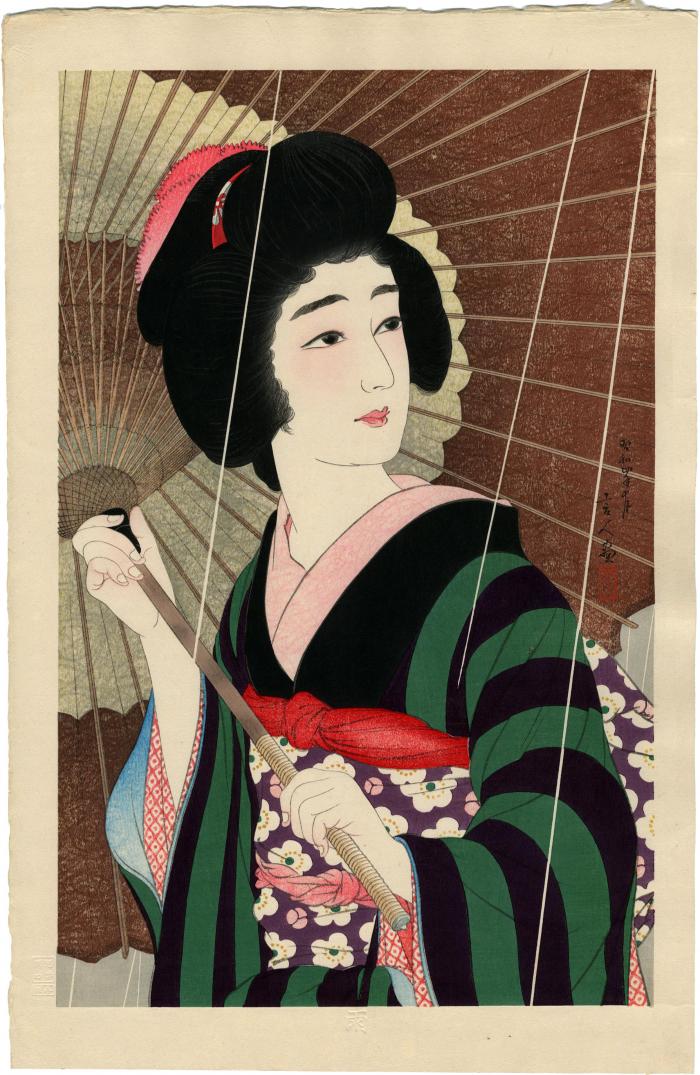Torii Kotondo (鳥居言人) (artist 1900 – 1976)
Rain (Ame - 雨: in blind stamped at bottom center just outside the printed area)
10/1929
11.75 in x 18.25 in (Overall dimensions) Japanese woodblock print
Signed: Kotondo ga (言人画)
Artist's seal: Kotondo
Date: Shōwa yonen jūgatsu
昭和四十月
Showa 4, 10th month
Title (embossed at bottom): Ame (雨)
Publishers' seal embossed in lower left:
Sakai Kawaguchi go ban
British Museum - number 134 of 200
Minneapolis Institute of Arts
Walters Museum of Art
National Museum of Asian Art
Yamamoto Art Museum
Ishikawa Prefectural Museum of Art
Allentown Museum of Art Lawrence Smith wrote about this image in the curatorial files of the British Museum in 1994: "As the attached label suggests, it was designed very much with the Western market in mind, presenting an image of the Japanese woman which foreigners preferred to see. It was shown at the Toledo Exhibition in 1930. This taste for young women with parasols or umbrellas had been nurtured by the 'Nihonga' painters Uemura Shoen (1875-1949) and Kaburagi Kiyokata (1878-1973), the latter passing it on to his pupils Shinsui and Kotondo himself. The artist uses here a much older Japanese convention in paintings and prints of representing rain by straight lines, but the low, dramatic point of view shows strong Western influence."
****
Sotheby's wrote the same information based on Smith's comments:
"Arguably Kotondo’s best known design, an impression of the print was exhibited at the Toleda Exhibition organized by Yoshida Hiroshi in 1930. It depicts a gracefully dressed young woman walking in the rain under the shelter of a waxed paper umbrella. Lawrence Smith comments that:
‘This taste for young women with parasols or umbrellas had been nurtured by the Nihonga painters Uemura Shoen (19875-1949) and Kaburagi Kiyokata (1878-1973). The latter passing it on to his pupils Shunsui and Kotondo himself. The artist uses here a much older Japanese convention in paintings and prints of representing rain by straight lines, but the low, dramatic point of view shows strong Western influence"
****
The tranliteration of the script along the right side of the print reads: Gaikoku-yuki nihyaku-mai-kagiri zeppan dai go jū ichi-ban Torii Kotondo.
外國行貳百枚限絶版 第五十一號 鳥居言人
****
This is number 51 of 200. The title is blind stamped at the center of the bottom edge just below the colored part. The publishers' seal is blind stamped outside the image in the lower left margin.
****
In The Women of Shin Hanga: The Judith and Joseph Barker Collection of Japanese Prints (p. 200) the entry notes the complexity of printing such a spectacular image. To that they add: "The combination of bokari and gomazuri techniques on the woman's bright obiage is especially delicate."
****
There is another copy of this print in the collection of the Ringling Museum in Sarasota, Florida.
****
Illustrated:
1) In 鳥居言人 Torii Kotondo, Gallery Beniya, 1995, p. 30, no. 21.
2) In black and white in 近代日本美人画展 : 伝統木版画を支えた作家たち Exhibition of Modern Japanese Beauties: Meiji, Taishō, Shōwa, Riccar Art Museum, 1982, n.p., no. 84.
3) In black and white as #131 in Modern Japanese Prints by Dorothy Blair, 1977 reprint. (Blair has noted elsewhere that Itō carved the blocks and that the printer was Wasakichi Komatsu.)
4) In black and white reproduction in The Japanese Print Since 1900: Old Dreams and New Visions by Lawrence Smith, page 69, number 45.
5) In color in The Women of Shin Hanga: The Judith and Joseph Barker Collection of Japanese Prints, edited by Allen Hockley, Hood Museum of Art, p. 201.
6) In color in The Female Image: 20th century prints of Japanese beauties, Abe Publisher, 2000, #173, p. 129.
7) In color in Seven Masters: 20th-Century Japanese Woodblock Prints from The Wells Collection, Minneapolis Institute of Arts, 2015, p. 192.
8) in color in 原色浮世絵大百科事典 (Genshoku Ukiyoe Daihyakka Jiten), vol. 10, p. 66, #231.
9) in color in The New Wave: Twentieth-century Japanese prints from the Robert O. Muller Collection, Bamboo Publishing, Ltd. and Hotei Publishing, 1993, page 199, no. 265.
10) in Modern Japanese Prints, 1912-1989: Woodblocks and Stencils by Lawrence Smith, Cross River Press, 1994, number 41.
****
6 prints of Kotondo's were published jointly by Sakai and Kawaguchi. The second edition of this print was published only by Kawaguchi.
modern prints (shin hanga - 新版画) (genre)
Sakai Kawaguchi (酒井川口) (publisher)
